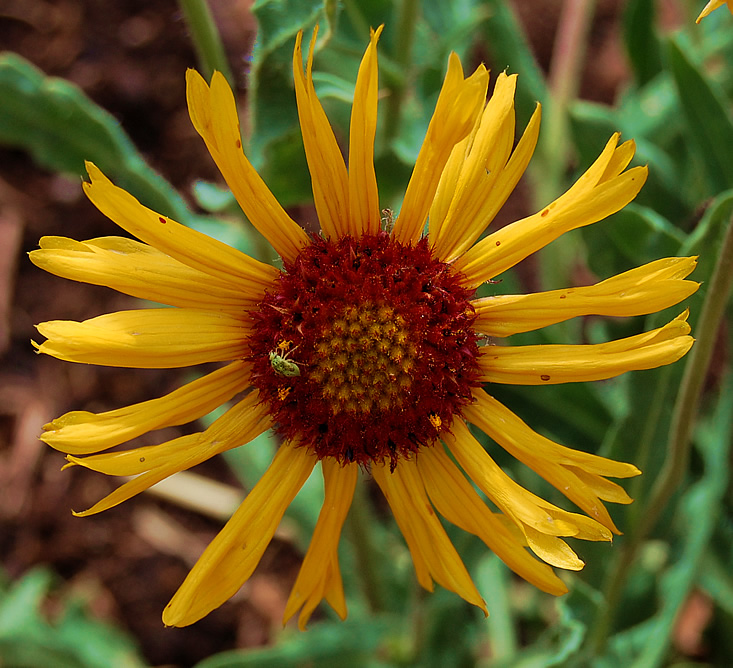|
|
|
|

 Dining at the Black-Eyed Susan
Santa Fe, New Mexico • May 31, 2009 To study a flower is a simple act with ample reward. The prerequisite is to slow down. In the hard-driving, clock-driven nature of daily life in the USA, slowing down the internal motor can present a challenge to the psyche. I can't tell you how to do it, but I'm confident you can. If you want to. Slow down. A slowed-down mind in a slowed-down body is now ready to approach a flower and take a long look at it. If you're looking in the spring or summer, it's likely that the buds have matured into blooms. It's highly likely you'll see a bug or two roaming about the surface of the flowers and leaves. The green critter on the black-eyed susan pictured here is typical of most guests at the vegetable feast. It has arrived for dinner and plans to stay awhile. Others of the insect clan will visit on the fly to quickly gather a trove of pollen. Eat and run. Slow down and look. Then look some more. Think about what you see. Reflect on it. And you're done. When you look up, your spirit is properly settled, and you're likely to spy a landscape rich in natural wonders. Or you can hop on your four-wheeler, fire-up the engine, and rip and roar through the badlands. Each to his own. A great country.
Family: Asteraceae The black-eyed susan comes from the extended family of daisies, headed by the towering sunflower, and the smaller clan of coneflowers, so named because their blossoms extend outward from a central cone. In the USA, little bands of black-eyed susans grow along the shoulders of roads and highways most everywhere east of the Rocky Mountains. You can also see them gathered in great maroon and yellow throngs in rural meadows and within the wider median strips of certain interstate highways. For the language wonks among us, the prefix "aster" means star, reminding us of disks and rays. Rudbeckia refers to the coneflowers and an obscure Swedish botanist who happened to know the master taxonomist, Carl Linneaus. Hirta translates as "rough, hairy," bringing us to the end of the taxonomy trail and the words var. pulcherrima. As best I can discern, the abbreviation "var." in the discipline of botany means "variety," though you could argue for variable, variant, or variation. Any one of the four gets the point across. It's the pulcherrima that adds the spice to the story. Pulcherrima means "most beautiful" and can be traced first to a star in an ancient constellation and then to the Virgin Mary. The star is called Epsilon Boötis by today's astronomers and astrologers, but back in the far-away day, the star was known by other names, including the Arabic Izar, meaning "loin cloth," the belt of the herdsman Boötis. He is the drover of the oxen who toil to keep the heavens in constant rotation. In the malleable realm of mythology, Boötis is also the ploughman, the grower of grapes, the strongman Atlas, and the guardian of Callisto after she was transformed into the Great Bear. To the Romans, the fourth star in Boötis was known as the pulcherrima, designating it as the loveliest orb in the array of the herdsman. It is fitting that among speakers of Latin, the name also became a loving honorific for the Mother of Jesus. Eventually, botanists and zoologists began to attach the superlative to flora and fauna — hence Euphorbia pulcherrima, the poinsettia or Christmas flower; Doritis pulcherrima, the beautiful Doritis orchid; Rhinoclemmys pulcherrima, the Mexican wood turtle; or Alectroenas pulcherrima, the blue pigeon. So, in the taxonomy we practice in the laboratory of Crow's Cottage, the black-eyed susan pictured here is not just a mere Rudbeckia hirta, but a Rudbeckia hirta var. pulcherrima. It's a beautiful thing. And.... Dig up a handful of black-eyed susans, cut off the roots and boil them in spring water, let the solution cool slowly into a warm salve, and you have a healing infusion for sores caused by tick and chigger bites, thorn pricks, and other natural afflictions to the skin. Some root doctors claim the juice of the roots can be rendered into a potion for the treatment of colds and worms in children, but I wouldn't recommend it — neither the treatment, nor the worms. We found the black-eyed susan for today's photo feature in the courtyard garden of the Randall Davey Audubon Center and Sanctuary on the mountainous outskirts of Santa Fe, New Mexico. The sanctuary and garden provide seeds for a future entry in our Glossary and Compendium. For now, our time is done. The gardens of Crow's Cottage are thirsty. The next wildflower or natural wonder, and those that follow in this series, shall appear here in the Crow's Cottage Glossary and Compendium. Notices of new entries are sent by e-mail express to my list of family, friends, students, and fellow travelers. If you've come here by some other means, I invite you to write me at the address below so I can add you to the list. Ebenezer Bowles Friday, July 17, 2009  L I N K S :
|
|

|
|
|